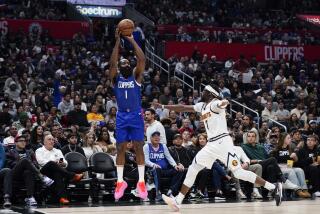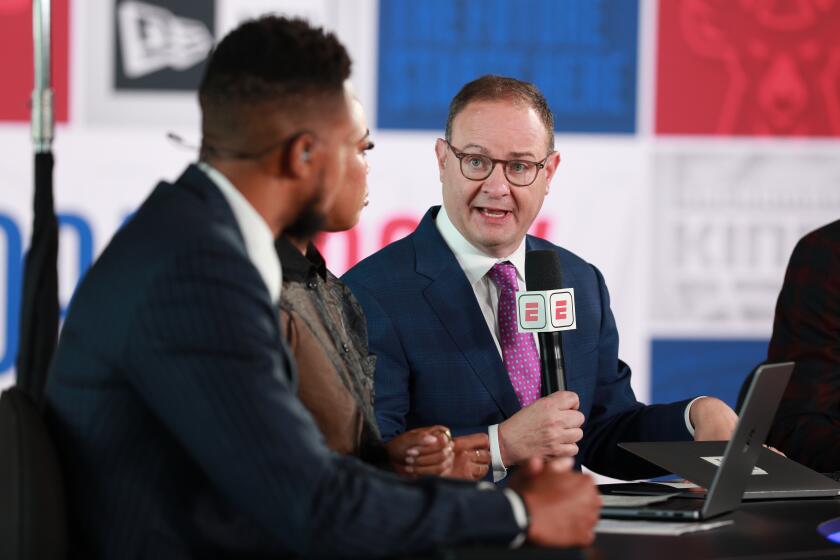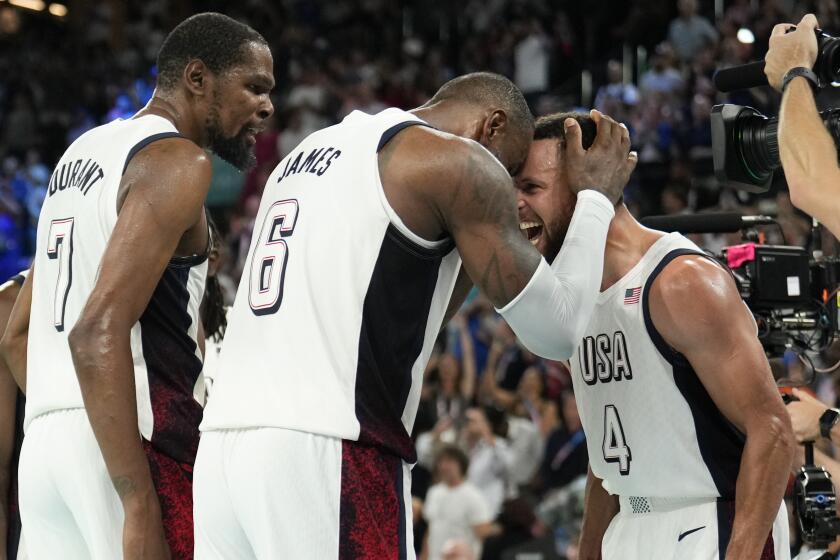Improving Their Defense by Leaps and Inbounds
Get to point guard Steve Nash before he gets the ball.
That’s one theory on how to slow down the up-tempo Phoenix Suns, who often get fastbreak baskets after opponents score.
Nash receives inbounds passes in stride, sometimes near midcourt, as teams retreat quickly on defense.
Having one player stick with Nash in the backcourt, the theory goes, might impede his progress enough to affect the Suns’ offense.
“Any time you’ve got a ballhandler, if you can get to a guy sooner, before he gets a running start on you, you’ll probably have a little bit better chance,” Coach Mike Dunleavy said. “That’s not always possible, but whenever you know your support is there behind you already, then it’s important to get up there. You’re trying to direct him to where you want him to go.”
During the Clippers’ 122-97 Game 2 victory Wednesday, Cuttino Mobley often jumped in front of Nash after the Clippers scored.
“I said we needed to get to him quicker,” Mobley said. “We needed to kind of slow his momentum down, but it’s easier said than done.”
*
Although the Clippers don’t want to play at the Suns’ pace, they ran, in certain situations, in the first two games at US Airways Center.
“We scored a lot of points in the first two games, but we’re not really pushing the tempo,” Dunleavy said. “We’ll run, but we want to keep it at our game. When we run, it needs to be for layups and free throws. When they run, they’ll run for three-pointers.”
*
Power forward Elton Brand is the Clippers’ best low-post scorer, but Mobley, Sam Cassell, Chris Kaman, Corey Maggette and Shaun Livingston also can score there consistently.
That’s why the Clippers are hard to cover, the Suns said.
“They’ve got a lot of good players offensively. Everybody can score on this team,” Phoenix center Boris Diaw said. “They made tough shots and post-ups. They put everybody on the post.”
*
Can the undersized Suns rebound, metaphorically and literally? They are accustomed to being out-rebounded, but, as forward Shawn Marion said Thursday, “Not by that big.”
The Clippers had 57 rebounds in Game 2, the Suns only 26. The Clippers had a whopping 14 more offensive rebounds than the Suns.
“We are going to get out-rebounded because we’re undersized but we can’t give up that many offensive rebounds and get out-rebounded by 30,” Marion said. “That won’t give us a chance to win at all.”
Sun Coach Mike D’Antoni saw it through a slightly different lens, pointing out Games 1 and 6 of the first round, in which the Lakers had better rebounding numbers but lost to the Suns.
“We’ve had two [playoff] wins with the exact same stats,” he said. “I can almost bet you right now we’re going to get out-rebounded next game.... You know why? Because we’re small. And it’s not going to change.
“It didn’t change against the Lakers when we beat them three times in a row. It’s not going to change now. That is where our weakness is, and there’s no way that we’re going to overcome that until Amare [Stoudemire] and Kurt [Thomas] come back and that’s not going to happen right now.”
*
The script sounded familiar enough after the Suns lost another Game 2 at home to a Los Angeles team. But the Suns preferred to think of last season instead of last series.
“Same as last year, when Dallas came in here and beat us in the second game and we go down and beat Dallas in the third game,” D’Antoni said, alluding to the 2005 Western Conference semifinals.
“If we’re better than the Clippers are, then that’s what we’ll do in the third and fourth game. If not, then they get to go on to the next round because they’re better than us.”
In the last series, the Suns lost Game 2 at home to the Lakers and the next two games at Staples Center. They rallied to become only the eighth team in league history to win a best-of-seven series after trailing, 3-1.
More to Read
Get our high school sports newsletter
Prep Rally is devoted to the SoCal high school sports experience, bringing you scores, stories and a behind-the-scenes look at what makes prep sports so popular.
You may occasionally receive promotional content from the Los Angeles Times.





